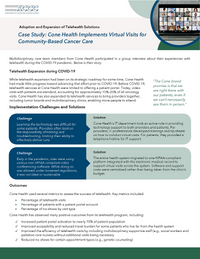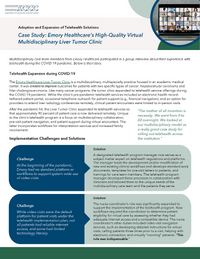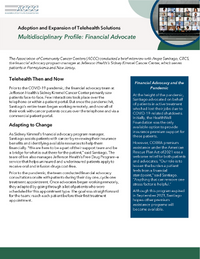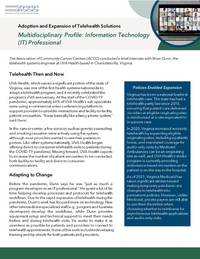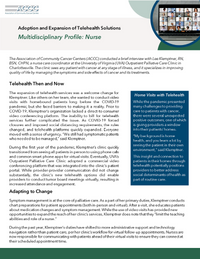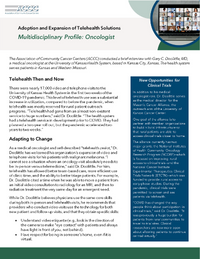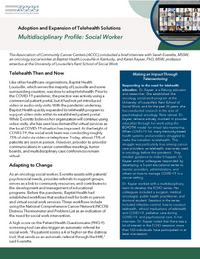Telehealth in Action

The COVID-19 pandemic has rapidly expanded the use of telehealth in cancer care across the U.S. Today, almost every health system provider is using telehealth to see patients—a stark contrast from pre-COVID-19 days, when patients had to seek out providers who were willing to give telehealth a try.1
As part of its Adoption & Expansion of Telehealth Solutions education project, ACCC documented successes in the cancer care community’s rapid adoption of telehealth to maintain patient care during the COVID-19 public health emergency. To obtain multiple perspectives on best practices in team-based telehealth delivery, ACCC conducted focus groups with multidisciplinary cancer care team members from three member sites: Cone Health in North Carolina, Emory Healthcare in Georgia, and Texas Oncology. ACCC also conducted interviews with oncology professionals across the country, including a financial advocate, an information technology (IT) professional, a nurse, an oncologist, a pharmacist, and social workers. Telehealth was defined as the exchange of medical and non-medical information from one place to another, between patients and providers, or among providers through multiple modes (e.g., telephone, video, patient portals, apps, etc.). ACCC conducted these focus groups and interviews in May and June 2021.
TELEHEALTH POLICY PRIMER
Several important federal policy actions during the COVID-19 pandemic facilitated the national expansion of telehealth in 2020-2021. Importantly, commercial insurers largely followed the federal government’s lead. Nearly all these changes were instated with the national public health emergency and are set to expire after the declaration is lifted. See below for a quick synopsis of important changes and follow the links to learn more.
- Centers for Medicare and Medicaid Services (CMS) waivers and flexibilities allowed providers to offer direct-to-consumer telehealth regardless of the patients’ location (e.g., in their home) or whether they were new or existing patients. They allowed any provider normally eligible to bill Medicare to bill for virtual visits during the public health emergency.
- Health Insurance Portability and Accountability Act (HIPAA) relaxation of privacy regulations allowed for communication between providers and patients over non-HIPAA-compliant platforms.
- CMS expanded the list of services allowed via telehealth, and permitted some services to be provided through audio-only instead of requiring video communication.
- CMS implemented telehealth payment parity, reimbursing in-person, video, and audio-only visits at the same rate.
- CMS allowed providers to be reimbursed for seeing patients virtually across state lines, if state regulations permitted.
- CMS allowed providers to prescribe controlled substances to patients through telehealth instead of requiring an in-person visit.
A TEAM EFFORT
Implementing a sustainable telehealth program requires collaboration among multidisciplinary stakeholders.
TELEHEALTH'S PROMISE
Telehealth visits can be a unique opportunity to improve patient access, patient experiences, and service delivery.
SUSTAINABILITY
Policy is a critical tool to advancing sustainable telehealth expansion within cancer programs and healthcare more generally.
A Team Effort. Implementing and expanding a sustainable telehealth program requires a considerable amount of institutional planning and collaboration among multiple multidisciplinary care stakeholders, including administrators, health information technology (IT) professionals, clinicians (including physician champions), patients, marketing professionals, and telehealth subject matter experts. The experiences of the programs and practices profiled here underscore the importance of an "all hands on deck" approach in which input and assistance are sought from multiple departments. This project made clear that there is no perfect system or workflow in implementing a telehealth program. Rather, telehealth can be adequately provided through a variety of technologies.
More important is adapting a given platform to fit existing patient workflows rather than modifying workflows to suit a specific technology. Training for care team members varied across these profiled programs, with some providing formal training, job aides/tip sheets, and ongoing technical support, and others providing little to no training and relying on care teams to leverage their existing familiarity with remote technologies. Provider satisfaction and effectiveness in telehealth delivery was highest when organizational coordination, training, and support were early and comprehensive. Advanced planning and preparation led to smoother transitions in the face of an emergency.
Telehealth’s Promise. Multiple interviewees described the unique opportunity to see patients in their home environments and how these occasions create further opportunities to think about whole-person care, potentially addressing social and other supportive needs through wraparound services. All participants mentioned how telehealth has increased access to support services including dietetics, support groups, and genetic counseling. Telehealth was also found to be effective for increasing access to educational offerings including chemo education, survivorship classes, and professional meetings such as tumor boards and cancer committees.
Patient-Centered Telehealth. While telehealth expansion offers unique opportunities to improve care access, patient experiences, and service delivery, there is no "one size fits all" approach. The success of these expansion efforts was in large part due to the recognition of and response to the needs of patients. One commonly cited challenge was the existence of disparities in access to and familiarity with technology, contributing to a digital divide among patients. Specifically, programs highlighted that this divide was most apparent for patients in rural or remote communities with limited broadband internet and elderly patients with limited technology literacy. Mitigation efforts included the provision of technology navigation services, flexibility in the types of telehealth services provided (e.g., offering both telephone and video appointments), and the consideration of specific appointment types and patient sub-populations for whom telehealth services are best suited.
Telehealth Policy and Sustainability. Program participants highlighted the importance of policy as a means to advance telehealth expansion within cancer programs and practices and in healthcare more broadly. The relaxed federal and state restrictions regarding communication platforms, eligibility, billing, and reimbursement in the wake of COVID-19 provided a pathway for increased delivery and uptake of telehealth services.2 Program participants noted that by providing short-term, limited licensing across state lines during the pandemic, state and federal regulators created new opportunities to expand access to patient care.
When the national public health emergency declaration is lifted, reverting to old policies would likely undo the progress that the cancer community has made in expanding telehealth. Specifically, payment reductions and restrictions would be a significant barrier to maintaining telehealth options for patients. CMS has already begun to outline what services and modes of communication will no longer be reimbursed beyond the public health emergency.1,3 Health systems, individual care team members, and patient advocates interested in sustaining telehealth access can join advocacy efforts through their professional and organizational membership associations and other advocacy groups.
Conclusion. While all sites experienced challenges in delivering telehealth, the general sentiment was that telehealth is here to stay to some degree or another. Now there is an opportunity to refine workflows, revisit training and supports for delivery and access, and assess infrastructure and interoperability to leverage telehealth for optimal cancer care.
References
1. McKinsey & Company. Telehealth: A quarter-trillion-dollar post-COVID-19 reality? https://www.mckinsey.com/industries/healthcare-systems-and-services/our-insights/telehealth-a-quarter-trillion-dollar-post-covid-19-reality.
Published 2021. Accessed August 3, 2021.
2. Royce TJ, Sanoff HK, Rewari A. Telemedicine for Cancer Care in the Time of COVID-19. JAMA Oncol. 2020;6(11):1698–1699. doi:10.1001/jamaoncol.2020.2684
3. Health Affairs Blog. Understanding
The Case For Telehealth Payment Parity. https://www.healthaffairs.org/do/10.1377/hblog20210503.625394/full/. Published 2021. Accessed August 3, 2021.
Acknowledgements
A publication from the ACCC project, "Adoption & Expansion of Telehealth Solutions." Learn more at accc-cancer.org/telehealth-solutions. In partnership with the GO2 Foundation for Lung Cancer. This project is supported by Lilly and Amgen.
The Association of Community Cancer Centers (ACCC) is the leading education and advocacy organization for the cancer care community. For more information, visit accc-cancer.org. ©️ 2021. Association of Community Cancer Centers. All rights reserved. No part of this publication may be reproduced in any form or by any means without written permission.







